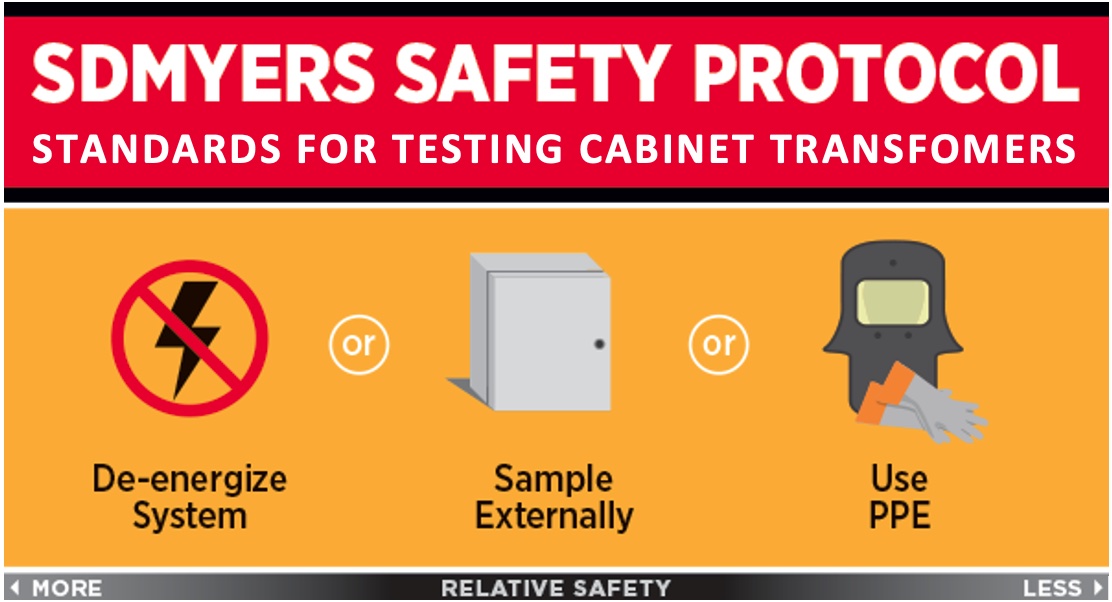News & Events

How to Avoid Downtime and Dangers when Sampling
SDMyers has three goals when obtaining oil samples for our customers. First, we must always comply with NFPA 70E safety standards. Second, we seek to eliminate the risk of electric shock injuries and arc flash. And third, we aim for zero downtime.
So, what is the most efficient and convenient method for sampling that aligns with the goals above? Let's explore three options and how SDMyers can help you with sampling from a cabinet-style transformer.
- De-energize
- Use Personal Protective Equipment (PPE)
- Sample externally
De-energize
Most cabinet-style transformers have a bottom valve inside the cabinet doors behind energized conductors on the secondary side. When opening a cabinet transformer, the threat of arc flash is serious and must not be taken lightly. The intense heat produced from an arc flash can result in substantial equipment damage and devastating personal injury, leading to high replacement costs and liability claims from anyone involved in the incident. These dangers from electrical hazards increase the moment the cabinet doors are opened.
Therefore, the most effective method to eliminate electrical hazards is de-energizing the cabinet transformer. Samples can be obtained from the bottom valve most safely at this time when the unit is powered down. Powering down your cabinet transformer provides the highest level of protection, but that means downtime is unavoidable, inconvenient, and potentially costly. No transformer owner wants to de-energize their electrical system and be inconvenienced with downtime. Sometimes, shutting down isn't even possible.
Use Personal Protective Equipment (PPE)
The NFPA 70E standard requires an Energized Electrical Work Permit if you cannot de-energize or elect not to. This permit is a written and signed document that justifies why work on the unit must be performed in an energized condition.
During this work, different levels of PPE are required for technicians servicing cabinet transformers. The transformer rating determines these levels, and the PPE becomes increasingly restrictive and bulky as the protection level requirements go up at higher ratings. The NFPA requires PPE that exceeds the incident energy level of that piece of equipment (the amount of energy released during an arc flash). Although PPE can be considered the least effective form of protection when working on electrical equipment, it can be the difference between life and death.


Sample Externally
Extending the bottom sampling valve outside the transformer cabinet is the most efficient and convenient method compared to the previous two options (de-energizing and wearing restrictive PPE for energized sampling). When technicians can pull a sample from the outside of an energized transformer, there is no need to de-energize. This is especially valuable in applications where transformers are daisy-chained, where the shutdown of one transformer affects several more in-line. This can affect a maintenance budget significantly.
An external valve providing access to the oil from outside the unit keeps technicians away from energized conductors in the cabinet. External sampling helps you avoid the dangers of arc flash and the inconvenience of downtime.
The SDMyers engineered solution to allow for external sampling is called SampleSafe™. SampleSafe™ external sampling devices eliminate the need to outfit technicians with additional PPE, allowing them to take samples without needing to de-energize the transformer. It is safe, reliable, and efficient.
Our friends, Safe and Reliable, show how it's done.
LEARN MORE ABOUT SAMPLESAFE™
The safest way to obtain samples from cabinet transformers without de-energizing is SampleSafe™. Learn more about our SampleSafe product options here.
And, if you're ready to avoid the dangers of sampling and the inconvenience of downtime, contact us to get started with a custom quote from an SDMyers Transformer Expert.
September 02, 2022
 Please wait while logging in.
Please wait while logging in.